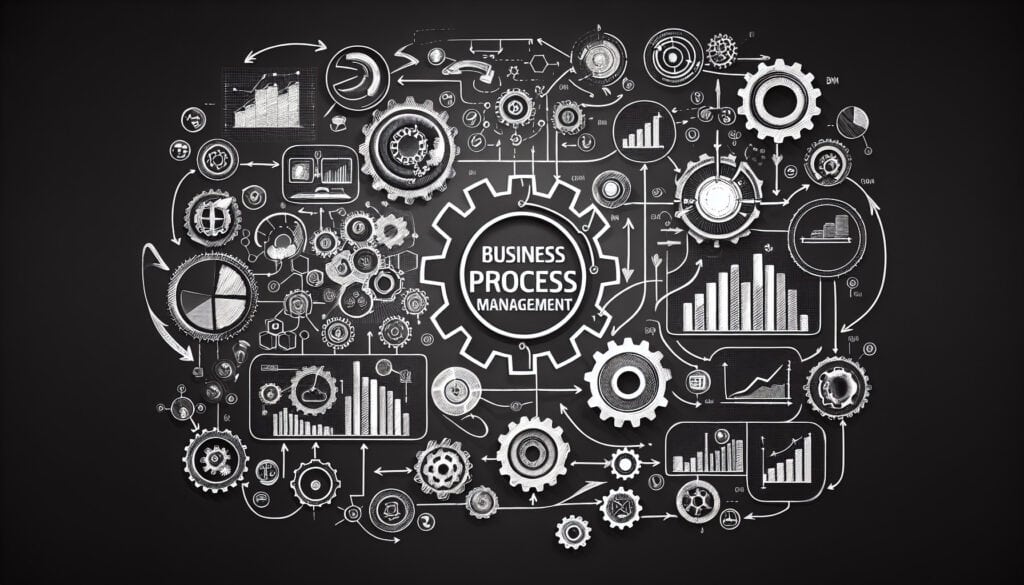Eine Disziplin, die verschiedene Methoden verwendet, um Geschäftsprozesse zu entdecken, zu modellieren, zu analysieren, zu messen, zu verbessern, zu optimieren und zu automatisieren.
- Methodologien: Kunden & Marketing, Ideenfindung, Produktdesign
Geschäftsprozessmanagement (BPM)

Geschäftsprozessmanagement (BPM)
- Agile Methodik, Geschäftsprozess-Reengineering (BPR), Kontinuierliche Verbesserung, Wirkungsgrad, Schlanke Fertigung, Prozessverbesserung, Prozessabbildung, Prozess-Optimierung, Wertstrom-Mapping
Zielsetzung:
Wie es verwendet wird:
- BPM umfasst die kontinuierliche und systematische Verwaltung der End-to-End-Prozesse eines Unternehmens, um Effizienz, Leistung und Flexibilität zu verbessern. Oft wird spezielle Software eingesetzt, um Arbeitsabläufe zu modellieren und zu automatisieren.
Vorteile
- Verbessert die organisatorische Effizienz und Agilität, erhöht die Transparenz und Kontrolle über die Prozesse und richtet die Geschäftsfunktionen auf die Kundenbedürfnisse aus.
Nachteile
- Die Umsetzung kann komplex und kostspielig sein, erfordert erhebliche organisatorische Veränderungen und Zustimmung und kann zu übermäßig starren Prozessen führen, wenn sie nicht durchdacht umgesetzt wird.
Kategorien:
- Lean Sigma, Herstellung, Projektmanagement, Qualität
Am besten geeignet für:
- Systematische Verbesserung und Optimierung von End-to-End-Geschäftsprozessen für mehr Effizienz und Leistung.
Geschäftsprozessmanagement (BPM) findet in verschiedenen Branchen wie der Fertigung, dem Gesundheitswesen, dem Finanzwesen und der Informationstechnologie breite Anwendung und erfüllt die Anforderungen an operative Exzellenz und Anpassungsfähigkeit in schnelllebigen Umgebungen. Im Zusammenhang mit Produktdesign und -innovation kann BPM in der Entwicklungsphase implementiert werden, in der Teams die Arbeitsabläufe im Zusammenhang mit Produkttests, Produktion und Kundenfeedbackschleifen analysieren und Bereiche für Verbesserungen identifizieren, um die Marktreife zu beschleunigen. Zu den beteiligten Akteuren gehören in der Regel Prozessanalysten, Projektmanager, IT-Spezialisten und Vertreter verschiedener Abteilungen, deren Tätigkeiten sich mit den fokussierten Prozessen überschneiden. Die Methodik umfasst die Erfassung der aktuellen Prozesse, um Ineffizienzen und Redundanzen aufzudecken. Anschließend werden verbesserte Arbeitsabläufe entworfen, die dann mit Hilfe spezieller BPM-Softwaretools automatisiert werden, die Echtzeitüberwachung und -analysen ermöglichen. Dieser systematische Ansatz stellt sicher, dass die betrieblichen Fähigkeiten mit den Marktanforderungen in Einklang gebracht werden, was zu einer besseren Ressourcennutzung und schnelleren Reaktionszeiten auf Kundenbedürfnisse oder neue Trends führt. Unternehmen, die BPM einsetzen, können nicht nur ihre Effizienz steigern, da Redundanzen abgebaut werden und die Rollenklarheit verbessert wird, sondern auch ihre Fähigkeit, sich an Veränderungen in ihrem Umfeld anzupassen, was besonders in Branchen mit kurzen Innovationszyklen und sich schnell ändernden Verbraucherpräferenzen von Vorteil ist.
Die wichtigsten Schritte dieser Methodik
- Identifizierung und Priorisierung von zu verbessernden Prozessen.
- Abbildung aktueller Prozesse mit Hilfe von Modellierungstechniken.
- Analysieren Sie die ermittelten Prozesse, um Ineffizienzen und Engpässe zu ermitteln.
- Neugestaltung von Prozessen für mehr Effizienz und Effektivität.
- Umsetzung von Prozessänderungen und Einbindung der erforderlichen Akteure.
- Automatisieren Sie neu gestaltete Prozesse, wo dies möglich ist.
- Überwachung der Prozessleistung anhand von Schlüsselkennzahlen.
- Kontinuierliche Verbesserung der Prozesse auf der Grundlage von Leistungsrückmeldungen.
Profi-Tipps
- Verwenden Sie Prozessanalyse-Tools, um bestehende Arbeitsabläufe zu analysieren und Engpässe und Ineffizienzen für gezielte Eingriffe zu identifizieren.
- Implementierung einer strukturierten Feedback-Schleife, die den Input der Kunden und die Vorschläge der Mitarbeiter zur kontinuierlichen Verbesserung der Prozesse einbezieht.
- Nutzen Sie die Automatisierung innerhalb der BPM-Software, um sich wiederholende Aufgaben zu erledigen. Humanressourcen die Konzentration auf höherwertige Tätigkeiten und Innovationen.
Verschiedene Methoden lesen und vergleichen, Wir empfehlen die
> Umfassendes Methoden-Repository <
zusammen mit den über 400 anderen Methoden.
Ihre Kommentare zu dieser Methodik oder zusätzliche Informationen sind willkommen auf der Kommentarbereich unten ↓ , sowie alle ingenieursbezogenen Ideen oder Links.
Historischer Kontext
1960
1980
1983
1990
1995
2000
2010
1950
1980
1980
1986
1994
1995
2000
(wenn das Datum nicht bekannt oder nicht relevant ist, z. B. "Strömungsmechanik", wird eine gerundete Schätzung des bemerkenswerten Erscheinens angegeben)














Verwandte Artikel
Master Production Schedule (MPS)
Massenanpassung
Marketing-Trichter
Marketing-Audit
MAPO-Index (Bewegung und Unterstützung von Krankenhauspatienten)
Fertigungsressourcenplanung (MRP II)